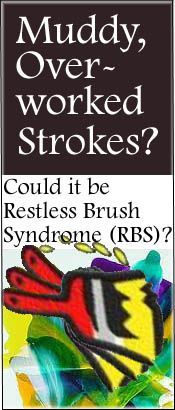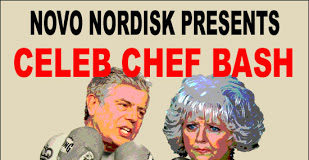 Restless Leg Syndrome (RLS) has been receiving a lot of attention these days because of all the recent Requip TV ads and in-office patient pamphlets. See, for example, “Restless Pharma Marketing.“
Restless Leg Syndrome (RLS) has been receiving a lot of attention these days because of all the recent Requip TV ads and in-office patient pamphlets. See, for example, “Restless Pharma Marketing.“
Little attention, however, is being paid to another debilitating syndrome, possibly related to RLS. I am talking about Restless Brush Syndrome or RBS as it is affectionately called. Although RBS is a common medical condition affecting up to 1 in 3 US artists1, not many people know about it.
Unfortunately, there is no Restless Brush Foundation that receives support from the pharmaceutical industry as many other patient advocacy groups do (for more on that subject, see “Pharma Tail Wags Patient Dogs“).
To find out more about this condition, I visited The Painter’s Key, an online community of artists and sufferers of RBS. The following are excerpts of discussions from this source. [Seriously, I can’t make this stuff up!]
“Restless Brush Syndrome is where the brush tends to move too much. It covers more ground than it needs in order to convey its message. [Something DTC ads can’t be accused of. — JM] This brush is as busy as a bee [some people disparage RBS and refer to it as “Busy Bee Syndrome” or BBS or Bunch of BS. — JM] — going here and there over areas that would often be best stated with a single, effective swipe. We’re not talking about legitimate blending and brushing out — we’re talking about going over the same place. You sometimes notice the condition at workshops and group paint-ins. Men as well as women can be sorely afflicted.” [Robert, The Painter’s Key]
“The tragedy is that restless brush syndrome, when chronic, can waste a lot of your precious time–time you need to grow, learn and flourish. It’s also responsible for some of the great sins of painting–muddifying, overworking and senilizing.”
Many RBS sufferers also are afflicted with RLS, which leads experts and painters to believe that the two are related.
“I have restless leg syndrome and I also suffer from the restless brush syndrome. I can’t stop applying colour and putzing around with my brush… then standing back and wondering what the heck is wrong with it.” — Violette Clark, an RBS AND RLS sufferer! [See The Painter’s Key]
Lessons for Requip Marketers
What causes RBS? How do RBS sufferers view themselves and their condition? Because there may be a link between RBS and RLS, the answers to these questions may help Requip marketers better position their product messaging. Luckily, sufferers of RBS are more vocal about their condition than RLS sufferers. They speak out, for example, on online message boards (eg, The Painters’ Key), which we can monitor.
 “Restless Brush Syndrome … may be a sign of insecurity (self-disbelief), dissatisfaction with life (in general) and the painting itself (in particular). It could be a form of doodling, automatic writing (Is anyone there?), or even an advanced form of that game we used to play as kids, blindfoldedly having to attach the tail to the pig or some other domestic animal, suffering devastating humiliation from the paralytic laughter of the onlookers when we got it wrong, which we usually did, having been pirouetted to dizziness beforehand.” — Faith Puleston, a German RBS sufferer [See The Painter’s Key]
“Restless Brush Syndrome … may be a sign of insecurity (self-disbelief), dissatisfaction with life (in general) and the painting itself (in particular). It could be a form of doodling, automatic writing (Is anyone there?), or even an advanced form of that game we used to play as kids, blindfoldedly having to attach the tail to the pig or some other domestic animal, suffering devastating humiliation from the paralytic laughter of the onlookers when we got it wrong, which we usually did, having been pirouetted to dizziness beforehand.” — Faith Puleston, a German RBS sufferer [See The Painter’s Key]
“Depending on your zodiac sign, RBS could be subversiveness, indecisiveness, self-negation or humbug [My emphasis — JM]. If you are into Feng-Shui, it might be a subconscious desire for a new order of things, a way of tidying up your life (finding inner meanings via outer balance?). A New Age fan might be exploring esoteric concepts for self-fulfillment, and people like me, terminally middle-aged and usually in too much of a hurry to think more carefully about what to do next, could be merely covering up the last set of brush-strokes which failed to have the desired effect.”
The Feng Shui Lifestyle Message
Here perhaps is information that Requip marketers can use: incorporate in your ads messages about lifestyle changes, such as the proper application of the principles of Feng Shui — the Chinese art of positioning objects, especially furniture, so as to optimize the flow of positive chi. [The “pins and needles” animation in the TV ad depiction of RLS symptoms is a perfect example of negative chi if ever I saw it!]
If the above narratives of RBS sufferers offer any clues, Feng Shui seems to play a role in alleviating RBS and could also be relevant to RLS. If so, Feng Shui, as a lifestyle change, should be part of the marketing messages directed at RLS sufferers. After all, principle #9 of PhRMA’s Guiding Principles for Direct to Consumer Advertisements About Prescription Medicines states:
DTC television and print advertising should include information about the availability of other options such as diet and lifestyle changes where appropriate for the advertised condition.
No Lifestyle Messages Here!
Unfortunately, GlaxoSmithKline, the marketer for Requip, is currently not paying any attention to Principle #9 in its TV and print ads. The patient pamphlet, which I have right here in my hand (see figure at left), does not have any information whatsoever about diet or lifestyle changes, like Feng Shui, for the advertised condition.From the looks of the “Creepy, Crawley” Requip ads, it appears that sufferers of RLS are Feng Shui challenged. I note the ’50s style furniture such as the green lounge chair. It’s the one image that sticks in my mind — there’s just something wrong with it and I just realized what it is! It emanates bad Feng Shui vibes!
RBS sufferers offer other lifestyle and diet information for people with RLS:
“How to take the cure? Unlike leg problems that can be beaten down with iron supplements, vitamin B12, and warm baths, the brush problem has to be cured by rewiring the neural paths.”
Hmmm… I don’t know about rewiring neural paths — I’m sure GSK will eventually seek FDA approval to market Requip for RBS as well as RLS. [The Feng Shui challenged ad agency responsible for the ads requires a different kind of treatment.]
The warm baths, however, sound like a reasonable alternative to ingesting a serious drug originally approved for Parkinson’s Disease!
Artists are optimistic about treating RBS on their own:
“Self-diagnosis and an understanding of your personal artistic direction and methodology may give you the prescription you need.”
Some even believe the condition is an asset rather than a true medical condition:
“Another consideration: How many really famous artists have had RBS? I would say Seurat had it in quite an advanced form, Monet and Pollock were also afflicted. But the admirers of these and countless other artists cannot all be wrong. Maybe we should have more of RBS rather than less of it!”
There’s a message here for RLS sufferers and marketers (who may suffer from another related condition: RMS – Restless Marketing Syndrome), which I know you’re dying to have me point out:
- the condition may be a natural consequence of aging rather than a medical problem
- lifestyle and diet changes may be viable alternatives to serious medication
- maybe it can’t be cured at all
- perhaps it’s all “humbug”
- the condition could be of some benefit to the sufferer
OK, the last item may be a stretch for RLS. Yet, perhaps some day we will identify the “Monet” (or the Lance Armstrong) in the RLS sufferers’ pantheon! [Forget about that weirdo Pollock — not a good role model as far as I am concerned!]
1Based on a controlled study of art for sale at malls. Data on file.









![6 Digital Tools at the Center of Healthcare Digitalization [INFOGRAPHIC]](http://ec2-54-175-84-28.compute-1.amazonaws.com/pharma-mkting.com/wp-content/uploads/2021/04/6DigitalTools_600px-100x70.jpg)




